#qiyi
Text
youtube
Live: Diensheng Galaxy 8M Unboxing and First Impressions by Squares or Something IDK
I got a magnetic 8x8. This is it
via YouTube https://youtu.be/huejuoVz2ls
#IFTTT#YouTube#cuber#speedcubing#moyu#gan#qiyi#rubiks#rubix#puzzle#sengso#shengshou#cubing#twisty puzzles#Squares or Something IDK#Youtube
6 notes
·
View notes
Text
youku saw cheng yi’s popularity getting bigger, and it truly is no joke. they have also enjoyed immense profit, high ratings for cheng yi’s dramas, and high engagement in less than a week after being announced as their spokesperson on their platform. they have to be quick and lock him down before he gets more drama deals with iqiyi and tencent or another big shot hehehe.
#oh dont mind me#i'm just enjoying thiiissss#go go go#cheng yi#qtalks#i'm just talking nonsense okayyy it's all my speculations about whats happening among those big platforms#but honestly i love the ring to it when cheng yi's drama is on iqiyi#like cheng yi himself said. iqiyi sounds a lot like qiyi#and the fandom name is called qiyiguo/kiwi. the fans are affectionately called guoguo#cheng yi. iqiyi. qiyiguo. qiqi. ee. seeeee it rhyyymmeeeeee#but no matter where he goes I'll be enjoying his acting performances#qiqi yiqi jiayou!
3 notes
·
View notes
Text
quick qiyi headcanons (mainly about her time at the lab)

in the lab her motto is the line 'he can't order me to stop dreaming' from the original Disney cinderella. 'He' of course being Brenner as she considers him the worst of the worst in the lab.
When she's stuck in a hospital gown in the lab she often tries to daydream it into a ballgown and often dances in her room. her little kitty plushie is her partner.
at one point, unbeknownst to her, it was discussed whether or not she needed to be put on some sort of sedating medicine like an anti-psychotic to keep her more docile until she learned. this was ultimately shot down due to concerns about it affecting her powers.
she was never believed about her death visions despite it being the reason she was brought in.
a lot of times the tests she endured included aggravating her and intentionally making her upset to try and trigger her telekinetic powers. it only worked half the time and she became better at keeping calm unless the test involved pain.
related to this, she'd never stay calm if told she was the reason her parents died. mainly because she knew it wasn't true.
after the lab she did not ever want to be alone for some time due to the many periods of time she was put in isolation during her time at the lab. this eventually stopped as she learned that she wouldn't be punished in such a way for misbehaving, and that the rules of what misconduct was were different as well.
although she's dyed her hair many colors over time, she decided to stay orange/strawberry blonde as an adult.
2 notes
·
View notes
Text
@hollowichor | starter call
It was the middle of the afternoon.
The middle of the afternoon meant that the Rainbow Room was half empty, with most of it's usual occupants being elsewhere for private lessons, while a handful chose the solace of their own personal rooms over the items the room had to offer. As such the room was mostly quiet....Mostly.
Mostly meaning quiet save for the repeated slaps of slip-on shoes against floor as Seventeen, in quite the burst of energy, was choosing to run around and around and around the centre of the room like the hounds of hell were at his heel. Sixteen was nowhere to be seen, off with one of the doctors for private lessons, and no doubt the absence of his somewhat more sedate twin had left Seventeen bored and needing to burn off some energy.
Round and round and round and round and....
#hollowichor#c: 017#thought i'd mix it up and give you one of the twins#let me know if you want me to change it though!#v: the rainbow room#we should plot something with qiyi and nine being terrors
2 notes
·
View notes
Text

WORDS TO DESCRIBE QIYI
eccedentesiast - Even after being put through intense experiments and tests that cause her lots of pain, she’s not one to cry that often. If she does, it’s when she’s alone. Around others she tries to be bubbly and uplifting to ensure people think she’s doing alright. Part of this is motivated by the idea that she might be able to escape if she does well enough.
straight forward - When talking to those who aren’t orderlies and Dr. Brenner she doesn’t mince words and, while not flat out blunt, she doesn’t cut around the bush. If someone wants her opinion, she’ll give it. Still, she’ll cover her feelings up for everyone.
effervescent (influenced by the eccedentesiast tendencies) - she tends to be extra bubbly when the mood around her is low. Sometimes people will say she sparkles.
reserved - this is more with orderlies and Dr. Brenner, but she tends to be quiet and doesn’t speak much. It’s mainly due to her wanting to behave and not make any issues. However she still appears happy as a facade.
3 notes
·
View notes
Text
the only problem with fics borrowing their titles from song lyrics is that, if the fic is particularly heart-wrenching, you will NOT be able to listen to the song anymore without wanting to cry
#this is a callout post to A Place To Hide (Can't Find One Near) by qiyie#i hadn't heard Lovely by billie eish and khalid before#so when it started playing on spotify#AND THE LYRICS CAME#AND I WAS LIKE. WAIT#THAT'S WHAT THIS SONG SOUNDS LIKE?#i got flashbacks from the fic and almost bawled#modao#lace speaks
3 notes
·
View notes
Text

@empath006 sent 📖 + 69 || the vampire armand
“It’s what they would think and feel that matters. And I have no time or place for it. Be merciful and wise.”

#this sounds like it's for a dnd campaign#thanks anne rice#i'm that thumbs up kid in front of the computer#i say you're asking me to follow you into mordor // answers.#i'm high#help#eddie x qiyi#empath006
0 notes
Text

Qiyi Ma - Message from the universe 1616, 2023 - Oil on canvas
45 notes
·
View notes
Text
1000 followers special: the history of the hakutaku
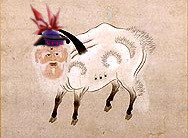
I recently hit a major milestone. It would appear that over a thousand people apparently want to see more on their dashboards. To celebrate, I decided to go back to the roots of this blog. While I doubt many of you remember it, some of my first posts were complaints about Touhou fanworks failing to account for the fact that the hakutaku was not a boogeyman, but a good luck charm.
In this article, I will explain how come, what exactly the role of an "auspicious beast" entailed, and how different people utilized the story of the hakutaku through history. I will also check how does the Touhou portrayal compare to the historical sources - though that's not the only case of modern reception you will be able to learn about.
As usual, more under the cut.
The earliest history of the hakutaku
As in the case of many other Japanese mythological beings, the history of the hakutaku actually starts in China. The creature was originally known as baize (白澤); hakutaku is simply the Japanese reading. The name can be literally translated as “white marsh”, but how it initially developed is unknown.
Donald Harper argues that baize can effectively be considered a deity. For what it’s worth, there is clear evidence that it could be invoked in theophoric names in the first millennium. The first known case is a certain Zhang Zhongkui (張鍾葵; obviously, his old name is related to the well known figure of the demon queller Zhong Kui) from Northern Wei, who was renamed Zhang Baize (張白澤) by emperor Xianwen. Crown prince Xiao Zhangmao of the Southern Qi was nicknamed Baize, too. Multiple other examples are apparently known, but sadly I was unable to track down any information beyond a confirmation they existed.
Generally speaking, the baize played an apotropaic role. Bernard Faure argues that the creature effectively fulfilled many of the roles of the fangxiangshi, a class of ancient exorcists. Pictures of it could be hung in houses to ward off malign spirits and misfortune. Textual sources indicate this custom was widespread among various social strata. Images of the baize could also be embroidered on clothes, banners and other items. An interesting practice tied to this is documented in sources pertaining to the life of empress Wei from the Tang dynasty. Reportedly her younger sister Qiyi (七姨) slept on a pillow with a depiction of the baize to ward off malicious spirits.
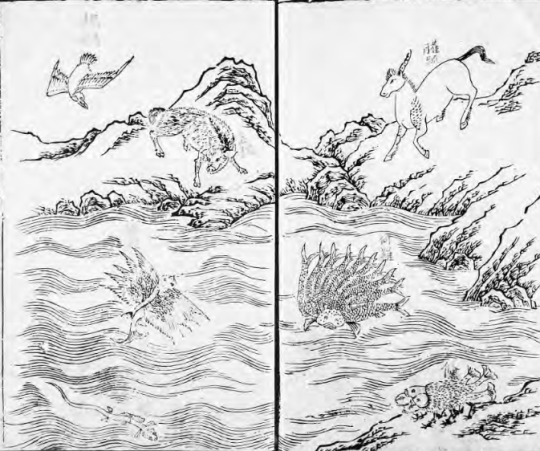
A typical illustration of various creatures from the Shanhaijing (from Richard E. Strassberg's translation; reproduced here for educational purposes only)
While the Tang period is when the belief in baize flourished, the creature was actually older. The first references have been dated to the fourth century. Sometimes even in academic publications you can find claims that it is as old as the Shanhaijing, but this is a mistake. It is true that copies of Shanhaijing which mention the baize exist, but they were only produced in the Ming period and the description was likely sourced from a contemporary encyclopedia, Sancai Tuhui. It is not impossible that the baize ultimately did originate before the Six Dynasties period, but this cannot be proven conclusively.
From Baopouzi to Dunhuang manuscripts: Baize, the Yellow Emperor and the Baize Tu
The first certain attestation of the baize has been identified in Ge Hong’s Baopuzi, which you might remember from my Ten Desires and Zanmu articles. In the section dedicated to the Yellow Emperor, the author states that in addition to his other famous deeds, this legendary ruler recorded the words of the baize.
A more detailed account of this event in preserved in a more recent source, the Yunji Qiqian, specifically in the chapter Xuanyuan benji (軒轅本紀; “Basic annals of Xuanyuan”, ie. the Yellow Emperor). It relays how the Yellow Emperor encountered the baize on Mount Huan (桓山) during a hunting expedition to the eastern frontiers of his kingdom, close to the sea. The creature appeared before him to share esoteric knowledge. It relayed that there are eleven thousand five hundred and twenty types of malign beings, the “spectral prodigies” (精怪, jing guai), in the world, and explained how people could protect themselves from each of them. There’s no real theme to the creatures mentioned: they include animal spirits, spirits of places and objects (for example a stove), as well as various beings which can be broadly described as genius loci. The key to overcoming them was to know their true names. This is not a belief unique to the baize tradition. The Yellow Emperor ordered this to be written down so that this knowledge can be preserved and further disseminated.
The compilation of baize’s advice came to be known as the Baize Tu (白澤圖), literally “Diagrams of White Marsh”. This tradition must predate Ge Hong, as he mentions the Baize Tu as a work which can be consulted to gain additional insights when it comes to repelling demons. However, he does not connect it with the Yellow Emperor legend directly. Multiple other sources attest that various variants of this treatise actually existed. Song shi (宋史; “History of the Song”), attributes its composition to a certain Li Chunfeng (李淳風; 602–670). Despite apparently relatively wide circulation, every single version of this work is now lost, save for a ninth or tenth century fragment discovered in Dunhuang, the so-called Baize Jingguai Tu (白澤精怪圖), “White Marsh Diagram of Spectral Prodigies”. It was originally identified by Jao Tsung-i in the 1960s, around 60 years after discovery. The surviving sections describe and depict some of the, well, “spectral prodigies”, as promised by the title, as you can see below:
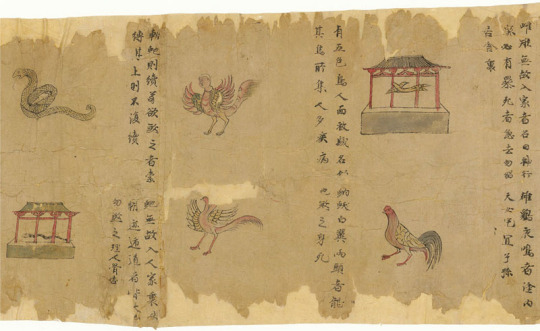

Illustrations sourced from a recent reprint of Jao Tsung-i's article, via Brill; reproduced here for educational purposes only.
Other manuscripts from Dunhuang mention the baize alongside Zhong Kui in the context of new year celebrations. As both of them were believed to keep nefarious forces at bay through different methods, it presumably felt natural to invoke both at once.
The Dunhuang texts discussing the baize do not contain any images of the creature. However, the exact same site did provide us with a depiction of it, most likely:
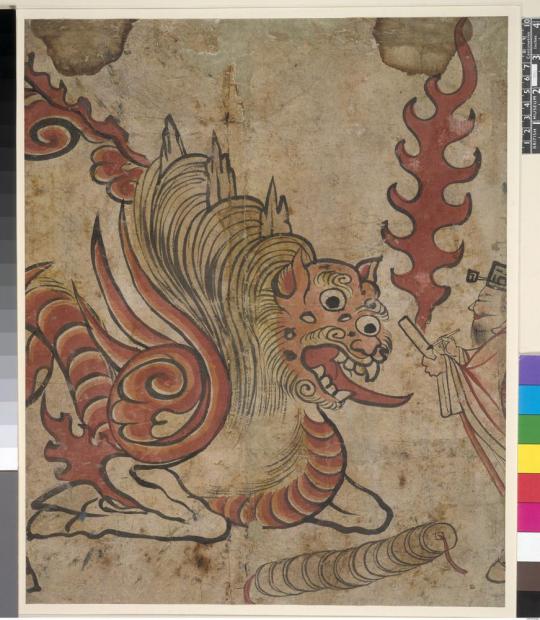
The supposed baize painting from Dunhuang (British Museum; reproduced here for educational purposes only)
While the enormous creature in painting above was initially interpreted as some sort of longma, according to Donald Harper its distinctly cow-like shape indicates it should be interpreted baize. The human figure is presumably a scribe, which might indicate we’re dealing with a pictorial version of the legend about Yellow Emperor’s encounter with the baize. After all, someone had to be present to write the creature’s advice down, as requested. The string of coins might be there to provide the image with further apotropaic qualities - the use of coins as talismans is a well established part of new year customs dating as far back as the Tang period. That’s actually where the modern custom of giving kids money in red envelopes comes from.
While the supposed baize painting is a unique and remarkable work of art from a modern perspective, it was likely not regarded as such when originally made. At some point parts of it have been cut, and a Buddhist woodblock print has been pasted on top of it (obviously they were separated during restoration). Before that it was presumably meant to serve as an ephemeral amulet, discarded after it had served its purpose.
This obviously does not diminish its value as a historical source. History is not just just about grand codes of law or royal declarations, as the fact that the study of the culture of some of the oldest states rests largely on the equivalent of receipts and school exercises. I guarantee that in a few hundred years trivial newspaper articles will similarly be the subject of serious inquiries.
Buddhist reception of the baize
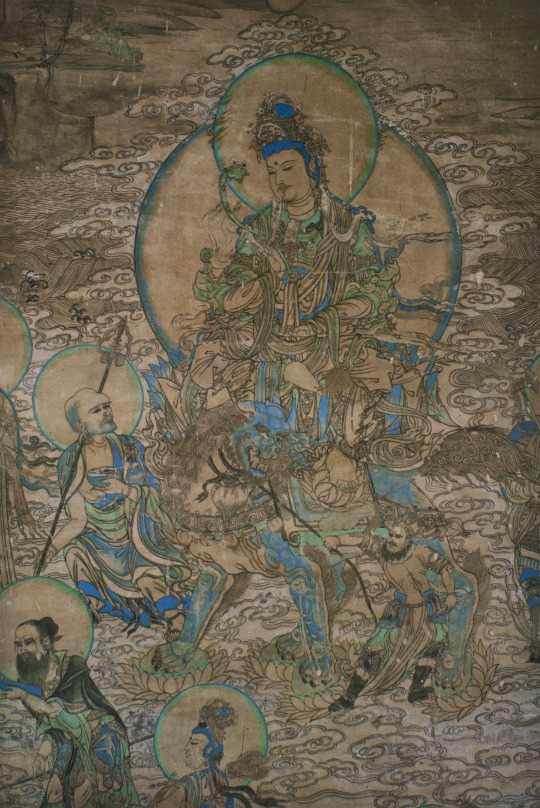
A Chinese depiction of Manjushri (wikimedia commons)
Baize also occurs in Buddhist sources from the Tang period, where the creature is linked to Manjushri. This was rooted in a new development, namely the reinterpretation of this bodhisattva as a figure associated with auspicious signs, rather than his traditional domain, wisdom. Additionally, it was presumably easy to link an at least semi-divine distinctly bovine creature with the custom of referring to certain buddhas and bodhisattvas with the title of “ox king” (牛王).
The first source to mention the association between the baize and Manjushri is a text written by the Buddhist monk Kuiji (632-682), a disciple of the famous Xuanzang. He states that a cow giving birth to a baize is one of the signs that the rebirth of Manjushri draws closer, similarly to a feng bird hatching from a chicken egg, a horse giving birth to a qilin, or an elephant with six tusks appearing. As you can see, the baize is in esteemed company here. For instance, the qilin was said to only appear to virtuous rulers, while the six-tusked elephant appears in the traditional account of the historical Buddha’s birth.
This tradition is also documented in the Sutra of Manjushri’s Auspicious Signs (文殊吉祥經,Wenshu Jixiang Jing), only known from a small fragment. Here the birth of the baize is actually elevated to the rank of the final omen in the cycle preceding the appearance of the eponymous bodhisattva. The text also alludes to the baize’s apotropaic role as a figure meant to ward off demons. Additionally it states that the creature normally lives in heaven, but can choose to reincarnate on earth, among humans - obviously to foretell the birth of Manjushri. Apparently all of the “auspicious beasts and numinous birds” rejoice when that happens.
The decline of baize in China
It seems that after the Tang period, the popularity of the baize declined in China, mostly at the expense of Zhong Kui. It was not a complete disappearance, but while the early baize largely belonged in the domain of popular belief, later on most attestations reflect courtly and scholarly interests only.
For unknown reasons at some point baize’s iconography was reinvented, with the ox-like form replaced by one with leonine features. The Southern Song encyclopedia Gujin Hebi Shilei Beiyao outright suggests baize is simply a term referring to lions. In a source from the Yuan period, a banner depicting the baize as a creature with “tiger head, red hair with horns, dragon body” is mentioned, though, so evidently not everyone accepted this rationalization.
Some references to the baize can still be found in texts from the Qing period. One example is a poem by a Tiantai Buddhist monk, Zhang Hengwu (張亨梧; 1633–1708), based on the well established Yellow Emperor narrative. In his version, the legendary ruler specifically seeks the baize while traveling to the east.
Japanese reception of the baize

The baize/hakutaku, as depicted by Gusukuma Seihō (wikimedia commons)
Baize’s illustrious career was not limited to one country. At some point, the creature was also introduced to Japan. Most likely it reached the archipelago either through Buddhist sources or Sa Shouzhen’s (薩守真) treatise Tiandi Ruixiang Zhi (天地瑞祥志; “Treatise on auspicious signs in heaven and earth”). The latter was transmitted to Japan as early as in the ninth century, and it is possible the baize - or rather the hakutaku, following the Japanese reading of the name - was already recognized as an apotropaic creature in Japan at this time. By the 1200s, the belief in its auspicious power was well established. Tachibana no Narisue states in Kokon Chomonjū (1254) that in the private chambers of the emperor (Seiryōden) there was an “oni room” (鬼の間, oni no ma) in which a painting of hakutaku repelling demons was displayed.
Japanese art did not adopt the younger Chinese convention of portraying the creature as leonine. It was not entirely unknown, with the best known example being an illustration from the Edo period encyclopedia Wakan Sansai Zue, but it never became popular. The ox-like shape remained the norm. The iconography of the hakutaku is thus pretty consistent: the body of a white ox, the head of an old man with a vertical third eye and sometimes a pair of horns, plus additional eyes and horns on the flanks. The human head might be a Japanese innovation, reflecting the ability of human speech ascribed to the creature.
Probably the single best known Japanese depiction of the hakutaku is that painted by Gusukuma Seihō (1614-1644). He was the official painter of the royal court of Ryukyu and somewhat of an international celebrity in his times, considering his work was renowned not just in his homeland, but also among Chinese envoys to Ryukyu and by the Tokugawa court. Sadly, this is his only surviving painting, unless there are more in private collections inaccessible to historians (this is not impossible, and reportedly a second hakutaku painting attributed to him belonged to a private Okinawan collector in the 1920s at the very least).
As noted by Bernard Faure, hakutaku was effectively a visual reversal of Gozu Tenno, who could be portrayed as a man with a bull’s head, and often played a similar apotropaic role. Additionally, through the title of “ox king”, which recurs in Japanese sources, hakutaku can be indirectly linked to many other major figures of esoteric Buddhism, including Daiitoku Myōō, Ishana and Yama. If you really want to stretch it you can even make a case for parallels with Matarajin, considering both his demon-repelling properties and his association with oxen.
Hakutaku and baku

The baku, as depicted by Hokusai (wikimedia commons)
As mentioned by the sixteenth century author Naotomo Isshiki (一色直朝), in addition to warding off demons hakutaku was also believed to eat bad dreams. This indicates confusion or conflation with the baku. The two are also treated as synonymous in Gen’i Nagoya’s (名古屋玄医; 1628-1696) Minkan Saijiki (民間歲時記 ; “Everyman’s record of the year and seasons”), which is about a century younger. He pretty clearly describes the hakutaku rather than the baku, since the “diagrams” known from Chinese sources and the Yellow Emperor legend are both mentioned. The original tradition must have been well known at least among

“King baku” (Gohyaku Rakanji website; reproduced here for educational purposes only)
By far the best example of this phenomenon of conflationg baku and hakutaku a statue from Gohyaku Rakanji (“Temple of the Five Hundred Arhats”) which depicts a hakutaku, but is referred to as “king baku” (獏王) today. It was originally sculpted by the monk Shōun (松雲; 1648 - 1710) in the late seventeenth century, much like the rest of the still displayed statuary. I actually first learned about the hakutaku in 2012 or so from the baku article on Zack Davidsson’s blog Hyakumonogatari Kaidankai, which mentions the Gohyaku Rakanji statue and the conflation between the two creatures. Lafcadio Hearn also asserted hakutaku is simply another name for baku.
Hakutaku in the Edo period
For unknown reasons the popularity of hakutaku increased in the Edo period, especially over the course of the eighteenth century. Sekien Toriyama included it in one of his compilations of yokai illustrations. He also refers to the hakutaku (or rather to baize, as the note is in Chinese) in his description of the narigama (a type of tsukomogami), stating that the way to get rid of this creature’s forerunner renjo was shared with humans by the auspicious beast.

The norigama illustration in mention (wikimedia commons)
Most importantly, amulets depicting hakutaku were used for protection while traveling and to ward off illness and misfortune. This custom relied on a Chinese source, the twelfth century treatise Sheshi lu (涉世錄), literally “Record of Experiencing the World” which prescribed hanging an image of the baize at home to prevent misfortune. This work is now lost and the relevant passage, known from quotations in Japanese sources, is its longest surviving section.
The increase in apotropaic usage of hakutaku images lead to the creation of the so-called White Marsh Diagram to Repel Ominous Prodigies (白澤避怪圖, Hakutaku Hikai Zu). This term refers to talismans consisting of a painting of the creature and a short version of the already discussed Yellow Emperor legend. It culminates in a scene with no Chinese forerunner, in which the hakutaku announces to the emperor that hanging an image representing it in a house protects from, well, “ominous prodigies”. A list of some of them was also provided.
The Zen monk Hakuin (白隱; 1686–1768) already describes the hakutaku talismans as popular, though he stresses neither he nor the people using them were aware of their origin. The precise history of their development remains unknown to researchers too. Seemingly they couldn’t be older than the seventeenth century at the earliest. Why did apotropaic images of hakutaku aimed at general population resurface in Japan centuries after their use ceased in China is unknown. Their spread might have been tied with the practices of the shugenja, as many of them were distributed among pilgrims visiting Mt. Togakushi, a well known center of the Shugendo tradition.
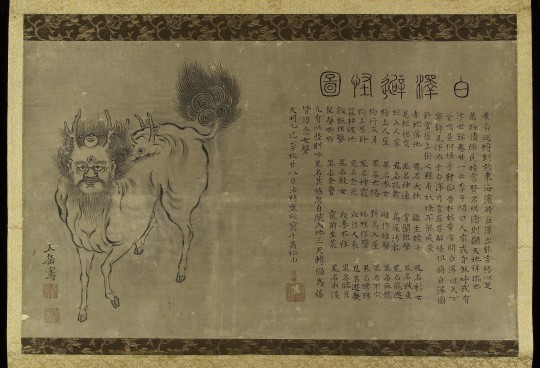
The most famous apotropaic depiction of hakutaku (wikimedia commons)
A well known example of the White Marsh Diagram to Repel Ominous Prodigies, presently in the collection of the British Museum, was painted by Gogaku Fukuhara, with the text provided by the Buddhist monk Bansen (盤旋). Based on the colophon of their work, it was completed on October 30, 1785. It’s worth highlighting that it situates the creature in Buddhist context (if that was not clear enough from the involvement of a monk), as the structure on its head is pretty clearly a wish-fulfilling jewel. To my best knowledge, this has no forerunners among Chinese depictions. This specific work of art has been characterized as a “deluxe” example of a talisman, painted and calligraphed by hand, presumably made with a connoisseur in mind. Most people relied on cheap woodblock prints instead for their hakutaku needs. These were obviously perishable, so few of them survive, though two of the woodblocks used to make them, both from Togakushi, have been preserved.
Notably, hakutaku talismans were employed during the cholera epidemic of 1858. Reportedly in Tokyo people placed them on their headrests before going to sleep. I sadly did not find any source explaining whether this was a conscious revival of the Tang custom discussed earlier, or if the similarity is entirely accidental.
Hakutaku talismans were also utilized by travelers. this custom is documented in an Edo period book which can be considered an early example of a travel guide, Ryokō yōjinshū (旅行用心集; “Precautions for travelers”) by Yasumi Roan (八隅蘆菴). It was published in 1810 as part of what can be described as an early case of a domestic tourism boom resulting in the flourishing of travel literature.
Much of the advice is surprisingly timeless, for example to abstain from leaving graffiti and stickers at landmarks such as temples and shrines, but also trees and sufficiently big rocks. I have to say the suggestion that a halberd is too heavy to carry around while on a trip is pretty solid too. Roan has many other great suggestions, but ultimately this is not an article about him, so they have to wait for another time. When it comes to the hakutaku, he states that travelers should equip themselves with images of this creature and the five great mountains of China (gogaku) to ward off spirits, but also wild animals and mundane accidents.
Last thing which needs to be discussed here is that in addition to the apotropaic paintings, hakutaku was also sometimes portrayed in the form of a netsuke. However, such depictions are apparently not common.
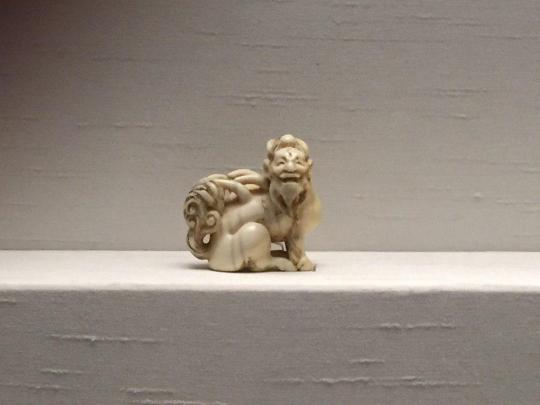
A hakutaku netsuke from the British Museum (photo proided by my friend Li)
The modern reception of the hakutaku
It remains unclear when apotropaic depictions of the hakutaku ceased to be made. It seems to me that it can be plausibly assumed it occurred in the Meiji period, but I have no solid evidence. However, the hakutaku was not entirely forgotten.
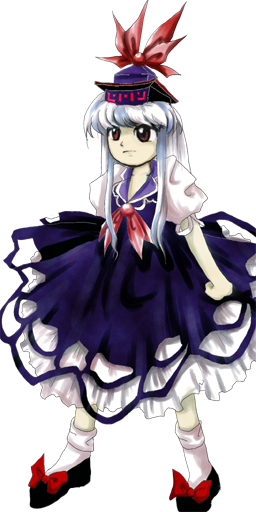
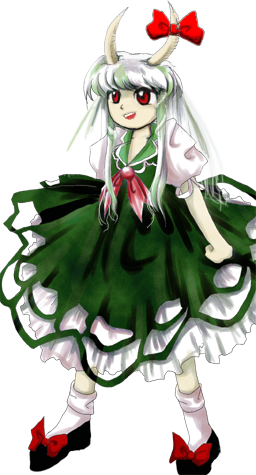
To my best knowledge, the single highest profile portrayal of a hakutaku in modern fiction is still Keine from Imperishable Night. What little spotlight she received paints an image remarkably close to the genuine accounts: as we learn from her bio, “she loves humans and always tries to help them” and she is pretty consistently portrayed as a staunch protector of the villagers and Mokou. The fact she’s not fully human doesn’t seem to be a mystery in-universe, and she is evidently accepted nonetheless. This doesn’t seem to be universally acknowledged in fanworks which is puzzling to me. There are dozens of yokai which are little more than boogeymen, but there are very few distinctly auspicious ones, and I prefer the canon approach of emphasizing that Keine and the village community mutually like each other.
Keine’s role as a teacher presumably is meant to be a nod to the lecture about malign spirits the baize delivered to the Yellow Emperor. I am a huge fan of specifying the school she teaches at is a terakoya; whether ZUN was aware of it or not, hakutaku talismans and temple schools are both expressions of Edo popular culture, so the theme does more or less fit together.
What little we learn about hakutaku in Touhou in general from Perfect Memento in Strict Sense also draws from historical sources. I will however note that as far as I can tell that revealing that a new ruler is going to be virtuous is a role assigned of various “auspicious beasts” like qilin, longma and so on in general rather than exclusively to the baize/hakutaku. There are also no legends about a hakutaku meeting with any Japanese rulers, even though most of Keine’s spellcards reference the imperial family (or attempts at overthrowing it; is she an anti-monarchist?).
The rest of Keine's character seems to be ZUN’s invention. The only account of the hakutaku (well, baize’s) origin makes it clear the creature is a type of supernatural cattle, not a human, and there is obviously no such a thing as a “were-hakutaku”. I presume this was meant to highlight her human side and tie her more closely to the moon theme of Imperishable Night, though I think her character would still work perfectly fine without that. At the same time, I won’t deny I wouldn’t mind getting some more insights into Keine’s backstory in the future. Nothing major, just something similar to the Ran hints we just got in Unfinished Dream of All Living Ghost.
There is also no strong connection between the hakutaku and recording history, though you can probably make a case that as a mainstay of chronicles and encyclopedias it does have a distinctly historical theme. I personally like this innovation, and especially how it is described in PMiSS.Touhou aside, it’s worth mentioning that a resurgence in the interest in hakutaku occurred in the early months of the covid pandemic. This is an example of a broader surge in interest in various apotropaic disease-repelling mythical and folkloric figures in response to the rise of the novel coronavirus (as you might remember, the amabie fad in particular even managed to cross language barriers). It probably helped that a statue representing the hakutaku was rediscovered in the Tennō-ji in Osaka recently.
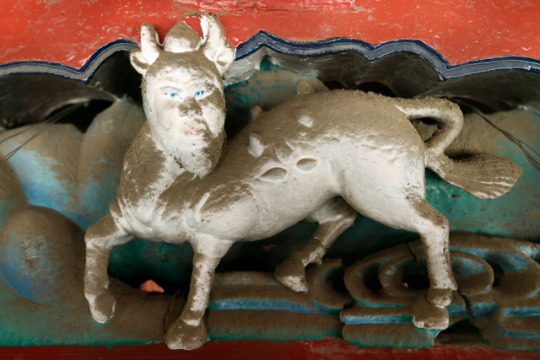
The Tennō-ji hakutaku (Asahi Shimbun; source contains more photos and a video. Reproduced here for educational purposes only)
Some of the articles covering the brief hakutaku resurgence seemingly confuse it with the kutabe (kudan), but these are actually two separate creatures. The source of confusion is probably Shigeru Mizuki, who did depict kutabe as notably hakutaku-like, since he believed the it was a local adaptation of the standard hakutaku narrative.

Shigeru Mizuki’s kutabe (reproduced here for educational purposes only)
Mizuki’s portrayal in turn influenced figures of kutabe made by local craftsmen from Takaoka in 2020. The English edition of Asahi Shimbun covered this in some more detail here, though ultimately it is beyond the scope of this article. As far as I know the connection, while plausible, does not permit full conflation, and in particular kutabe never attained the sort of religious significance hakutaku once had.
Bibliography
Bernard Faure, Rage and Ravage (Gods of Medieval Japan vol. 3)
Donald Harper, 'Hakutaku hi kai zu' 白澤避怪図 (White Marsh Diagram to Repel Ominous Prodigies)
Donald Harper, Pictures of Baize / Hakutaku 白澤 (White Marsh): Ephemera and Popular Culture in Tang China and Edo Japan (not accessible online but there is a digital lecture version on youtube)
Jao Tsung-i, Postface to the Two Dunhuang Manuscript Fragments of the Baize jingguai tu 白澤精怪圖 (White Marsh’s Diagrams of Spectral Prodigies; P.2682, S.6261)
Richard E. Strassberg, A Chinese Bestiary: Strange Creatures from the Guideways Through Mountains and Seas
Kathryn Tanaka, Amabie as a Play in Kansai
Constantine N. Vaporis, Caveat Viator. Advice to Travelers in the Edo Period
110 notes
·
View notes
Text
TGCF map?
While I’m writing a fic and looking for a map, I found this fan made map on reddit thread:

Source: a reddit thread
Unlike the map in MDZS, this fan-made map of TGCF is like any other map in fantasy settings (eg LOTR, Final Fantasy series, anime One Piece/HxH, etc).
But what if the TGCF world itself uses China map as reference like in the MDZS?
Because there is one location that also exists in the real world, namely: the Gobi Desert.
Ke Mo demanded, “Our kingdom had disappeared in the Gobi for over two hundred years. You are not of our people, why do you know our tongue? Who are you?” (TGCF chapter 24)
Xie Lian immediately said, “General Ke Mo, I think you’ve mistaken something. We’ve traveled across the Gobi desert to get rid of the Guoshi of Banyue, how can we be the helpers she sent for?” (TGCF chapter 26)
And here is the location of Gobi desert:

So I want to try guessing the locations in TGCF are, which, although the names are fictional, are based on real locations.
Like Morioh and S city in JoJo which are said to be based on Sendai, Miyagi prefecture.
Before proceeding, remember that this is a fan-made and not a serious project either. This is purely headcanon so you are free to agree or disagree, if you prefer your own headcanon then so be it.
First, regarding the location of Mount Tonglu (Wuyong), I was looking for a map showing the locations of volcanoes in China and found this:

However, I didn't really check the history of these mountains, so I more or less made up the location of Mt. Tonglu here:

The map above is for the event circa 2000 years ago, since volcano eruptions by a single mountain was capable to buried the entire Wuyong kingdom, it made me think that Wuyong's territory wasn't that big.
Besides that, I was inspired by the "No Paths Are Bound" fanfic which brought Xianle into the history of Wuyong. Moreover, it was mentioned that for the people of Wuyong, they tried to invade other kingdoms to take over their land & have their people move in. Thus, I’ve made Xianle and Xuli bordered Wuyong.
Most readers believe that Xuli was located in the north, considering Pei Ming's domain (although I don't think it really has to be, because Xuli kingdom had already fallen during present time which I think, its location is no longer necessary where).
There is also Zhaoyi, my made up kingdom for my fic (therefore, not canon). I was inspired by the timeline of the Xia dynasty era where the royal territory was not as big as during imperial era, so I also made Xianle’s territory quite small as well.
Generally in every dynasty there is always territorial upheaval which often ends with one dynasty overthrowing another. In this fanfic of mine, I want to make sure that the Zhaoyi kingdom will be absorbed by Xianle. Yong'an itself was part of another country in the past which will be taken by Xianle.
The old capital of Zhaoyi is Qiyi. Qiyi itself is actually the old name of Qishan. Again, I got inspired by NPAB to incorporate MDZS’ places in TGCF. The name 'Zhaoyi' itself is taken from the history of Qishan County in the Spring and Autumn period during King Wu’s reign (Zhou dynasty) as one of its state; Shao (召 or 邵).
Regarding Lang’er bay location, I’ve made it based on Qinghai lake. Wait a minute, why the lake? Isn’t it a bay? The initial fan-made map is correct in seeing the concept of Lang'er bay as a ‘truly bay’. But I want to match the location of Lang'er bay to the map of China, which according to TGCF, located to the west of Xianle. The problem is, to the west of China there are no bays! Therefore, I tried to redefine the word 'bay' and I came up with this:

Thunder Bay! According to wiki, Thunder Bay is a large bay on the northern shore of Lake Superior, in Thunder Bay District, Ontario, Canada.
In addition, in Qinghai Lake itself there is a spot called “Fairy Bay Area”.

Years later, Wuyong had fallen, its territory was absorbed by Xuli. Xianle itself was expanding its territory and managed to seize part of Zhaoyi's. Zhaoyi moved the capital in unknown location (presumably around Yong’an, which still belonged to said kingdom). Also, moving the capital was a common thing to do since a long time ago.
During this time, Banyue and Yushi were found. It is noted that Banyue was located around Gobi desert and Yushi was a kingdom far to the south of Xianle. The blank territory between Xianle and Yushi can be filled with any random countries.

As time went by, Xianle and Xuli were keep growing. The Zhaoyi Kingdom finally fell and Yong'an officially became a part of Xianle. Despite that, some remnants of Zhaoyi still exist as autonomous zone led by rebels.

Circa 800 years ago, Yushi eventually fell and became part of Xuli's territory. You can see how ambitious Xuli country was back then (like the Mongol empire). Xianle itself began to clash with Xuli and managed to seize part of its territory. However during this tension, Banyue took its chance to absorb the autonomous zone of Zhaoyi. More places are revealed.

Less than a decade later, the fall of Xianle happened as a result of the civil war with the Yong'an rebels. Feng Xin mentioned that Yong'an obtained help from other countries secretly. Thus, given the tension between Xianle and Xuli, I presumed that it was Xuli who was secretly helping Yong'an (and also some of the rebel descendants of Zhaoyi who held grudges against Xianle). Actually some of the Xuli people prayed to Pei Ming, but Pei Ming paid no heed, considering that King of Xuli at that time made him break his sword.
During this time, there was a new dynasty that was starting to grow which would become the home country of Shi Wudu, Shi Qingxuan and He Xuan.

The decline of Xuli was starting to happen, as Yong’an and the unnamed country absorbed some of its territories. Yushi's region was eventually taken over by the unnamed country. Yong'an itself became a bigger country than Xianle, its territory reached the eastern edge (which would become Lang Qianqiu's domain later).
The location of Mount Yujun is revealed. Mount Yujun itself is said to be in Pei Ming's domain (north), because we already believe that Xuli is in the north, then Mount Yujun itself is located in Xuli.

Xuli had finally fallen while Banyue itself kept growing. Ling Wen and Pei Ming were responsible for the fall of their own kingdom (lol), I thought the latter agreed to participate because he saw how corrupt his nation had become. Xuli is then divided into several countries which I don’t bother to name and set the regional boundaries.
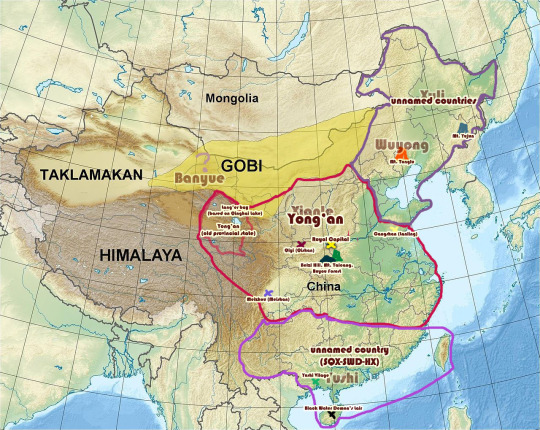
Circa 200 years ago, Banyue eventually was eradicated by Yong’an. Some years ago (it was not necessary to coincide with the fall of Banyue), the Black Water Demon Lair was discovered. According to TGCF, Black Water Demon Lair is located in the South Sea.

In the southern part of China there is a tropical island called Hainan, a place that I think is suitable for Black Water Island. In the middle of Black Water Island, there is Black Water Lake, and coincidentally:

On the island of Hainan there is also a lake. In the middle of the lake, there is also a small island that I actually wanted to make the location of the Nether Water Manor on, but I just remembered that the manor is like being in separated dimension (iirc underwater inside the lake).

Finally, Yong'an nation also fell and was divided into several countries (which again, I careless to name and set their territories). More places relevant to the plot are revealed (including the MDZS’ one as a tribute to NPAB). In the end, the largest country is Shi Qingxuan’s unnamed country (lol), and also in the Himalayan region there are several unnamed countries.
Interestingly, in the present timeline of TGCF, there aren’t named countries that are still standing.
Specifically below is a map showing the domains of the martial gods:
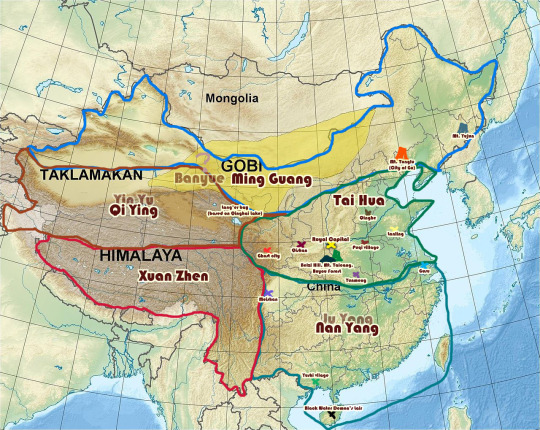
The domain divisions are purely made up and not based on regional divisions used IRL.
Thank you to those of you who have read up to here. I made this not to ridicule the fantasy map, not at all. In fact I think the TGCF storyline will be more in line with the fantasy map. It's just that I was challenged to use a map of China thanks to the existence of 'Gobi Desert' the novel mentioned.
#tgcf map#tian guan ci fu#tgcf meta#china map#fan made theory#my headcanon#mxtx crossover#alternate universe#heaven official's blessing#no paths are bound#loss of history
197 notes
·
View notes
Text
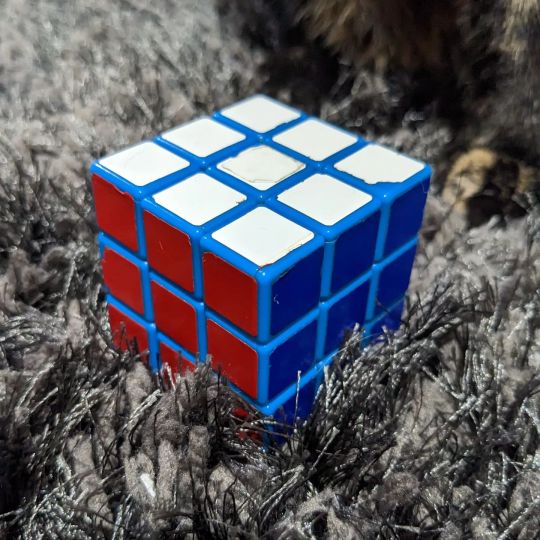
#IFTTT#Instagram#rubik#rubiks#rubix#cuber#cubing#speedcubing#speedcuber#moyu#qiyi#mfjs#mofang jiaoshi#puzzle#puzzlecubesolved#cubinglife#cubeography#twisty puzzles#cubos#cubes#jigsaw#twistypuzzles#rubikscube#cuboderubik
3 notes
·
View notes
Text
courage of stars ch2 | writer's commentary
Wow, people are still reading this fic!! Amazing!! Thank you so much gang, I so appreciate it...
Shorter notes today, however still a couple of things that would get too wordy for an author's note on Ao3, so let's get to it!
***
Cheng Xiaoshi looked back and immediately skidded to a stop. Behind him were his parents, but so were a wave of hundreds of parents clinging to their children. Instead of a stone path of combed dirt, everyone was running and tripping over wild, untamed trees. The sound of sirens howled in the distance.
Cheng Xiaoshi cried out to his parents, but he had lost his voice along the way. He didn’t understand what they were running from, or to where they were going, but his heart thundered with their fear. He wanted to run with them, far from the planes and the bombs that pelted the city below.
So if it isn't clear in the narrative, Cheng Xiaoshi is essentially traveling through time in this whole section. Particularly, he has stumbled about sixty-some or seventy years into the past, during the Japanese invasion during the Second World War. The Japanese bombed China quite a bit, and quite frequently as well. Civilians had to run to the mountains for safety, wait until the damage was done, and then come back down. Give or take some time, the bombers come back, and then up the hill the civilians went once more.
***
He was no longer on the mountaintop among the fleeing civilians. He was in a disheveled room, furniture thrown aside and clothes shredded on the floor. The soldiers with their rifles and bayonets were laughing and talking in a language that Cheng Xiaoshi could not understand. At their feet, a young woman was splayed out on the wooden floor, eyes dull with death.
He was too young to understand why the soldiers laughed at her, bloodied broomstick in hand. In truth, he would never be old enough to understand why. It was impossible to accept.
He knew this was the little children’s mother. Somehow, he knew this was a year before his soul crossed their path on the mountain.
One of the reasons this story's rating is bumped up to an M. One of the many atrocities committed by the Japanese Imperial Army at the time was violent and nightmarish sexual assault, which was often paired with bodily mutilation. This is most famously done in Nanjing (aka Rape of Nanjing, or the Nanjing Massacre) on a massive scale. So my understanding of these children were that they were not originally from Guidu, but have come here to escape.
***
I should also note that Peidi University is not a real university (as far as I'm aware). It is a fictional name!
***
The second box–his father’s antique cameras, that Cheng Xiaoshi swore he would keep in better condition. A Dalai camera from the fifties, that his grandfather once used before Cheng Xiaoshi was born. A Qiyi camera that his father collected–the first official Chinese camera, now wrapped up in his mother’s old scarf to protect from gravity and time. A Nanjing model that he remembered Baba telling him stories about the camera’s history, but Cheng Xiaoshi couldn’t remember any of them.
Shoutout to this website for giving me a wonderful list and history of Chinese-branded cameras created during the Cold War! Cameras were such a high-end rarity for a great deal of the 20th century, so it was always special when someone had one, and was able to take family photos with it. I always laugh at Hasan Minhaj's joke in his Homecoming King special on Netflix when he talks about how his mother was the most sought after woman in town because her family had a camera(!!), because that's so very relatable.
9 notes
·
View notes
Text
plot ideas (Qiyi edition)

Stuff in the lab. Her interacting with other kids and with orderlies or other staff.
stuff immediately after she escapes. Her learning to trust again and people being weirded out by her being alive. she was declared dead after all.
vulnerable qiyi things really. her going to eddie for weed to help her relax. or her opening up with people about what happened.
also just. . . badass qiyi??? qiyi with a gun????? Nancy's got a shotgun for the biggies, Qiyi's got a pistol for the small ones. Or for anyone trying to get in their way.
Outside stranger things? Death Seer Qiyi in a fantasy setting or a more sci-fi/dune/star wars setting. Her being confused if an immortal comes to her for help and she can't see their death.
goddess of death qiyi!!! its right there!!! D&D stuff, find her a champion!
Critical Role: qiyi being a follower of the matron of ravens. OR her being a champion in training of sorts. She sees Vax in dreams and he leads her through her tasks until she finds the deathwalker's ward and takes it on.
3 notes
·
View notes
Text
it’s OK if your cis and you have a fushigi ball. it’s OK if you’re cis an you have a GAN356 Air SM. It’s ok if yr cis and you have a Coogam Qiyi Megaminx. its ok if ur cis and u have a YJ MGC 4x4. what’s NOT okay is if you’re cisgender and you have a Purple GAN 11 M Pro Limited Edition 3x3; Hand It Over.
79 notes
·
View notes
Text
What Horror Trope Are You?


The Killer
was there ever a choice? maybe, but that fork in the road is far, far behind you. you surround yourself now with sharp things, tools to harm, and they have become your only family. you are the thing that goes bump in the night, and you hunt for scurrying mice like a hungry cat. maybe, just maybe, though, one can finally put an end to your hunt, and allow you to finally rest.
2 notes
·
View notes
Text
qiyi releasing a 56cm magnetic pyraminx is so fun. enter my gamer lair and witness my trendy decoration

3 notes
·
View notes